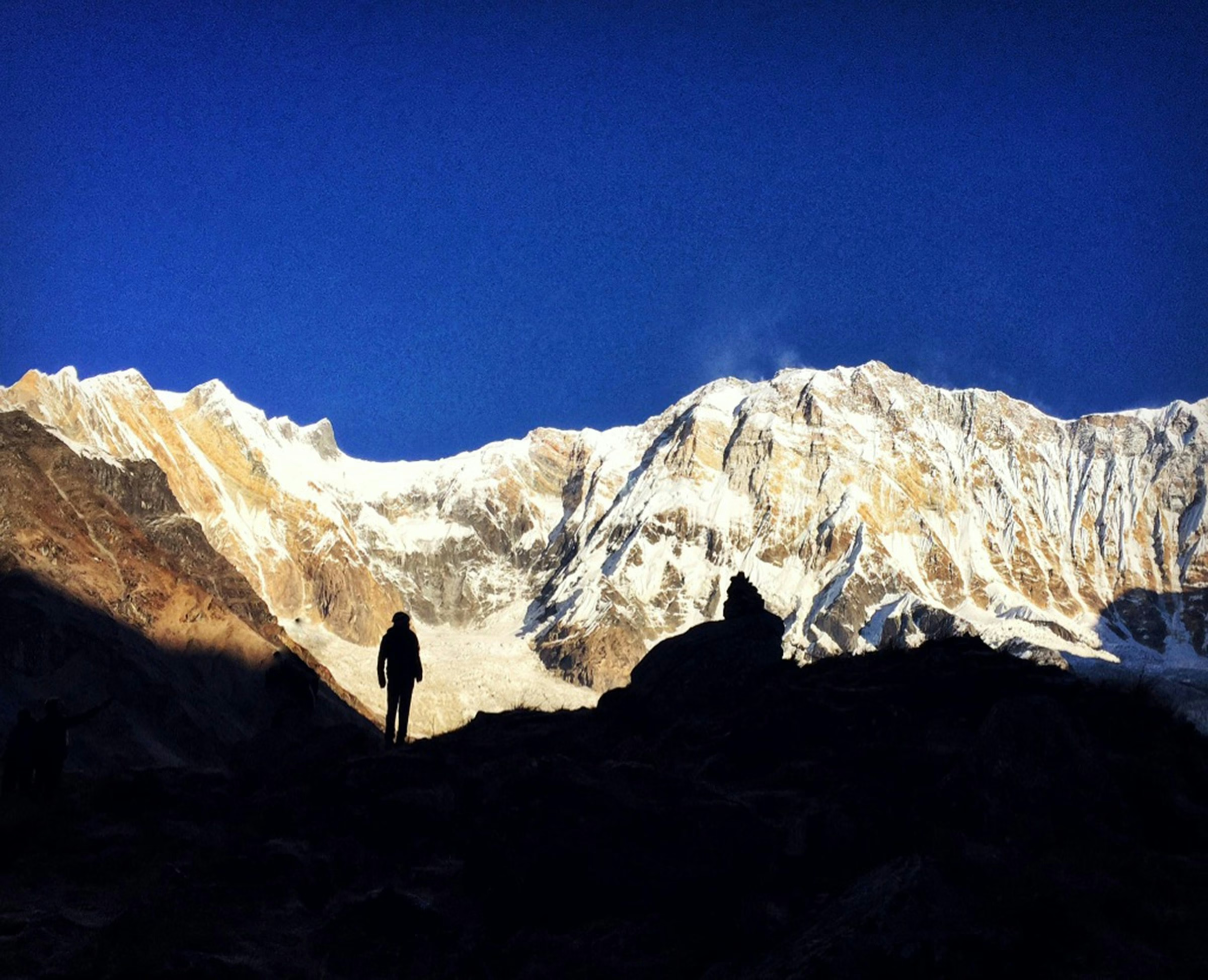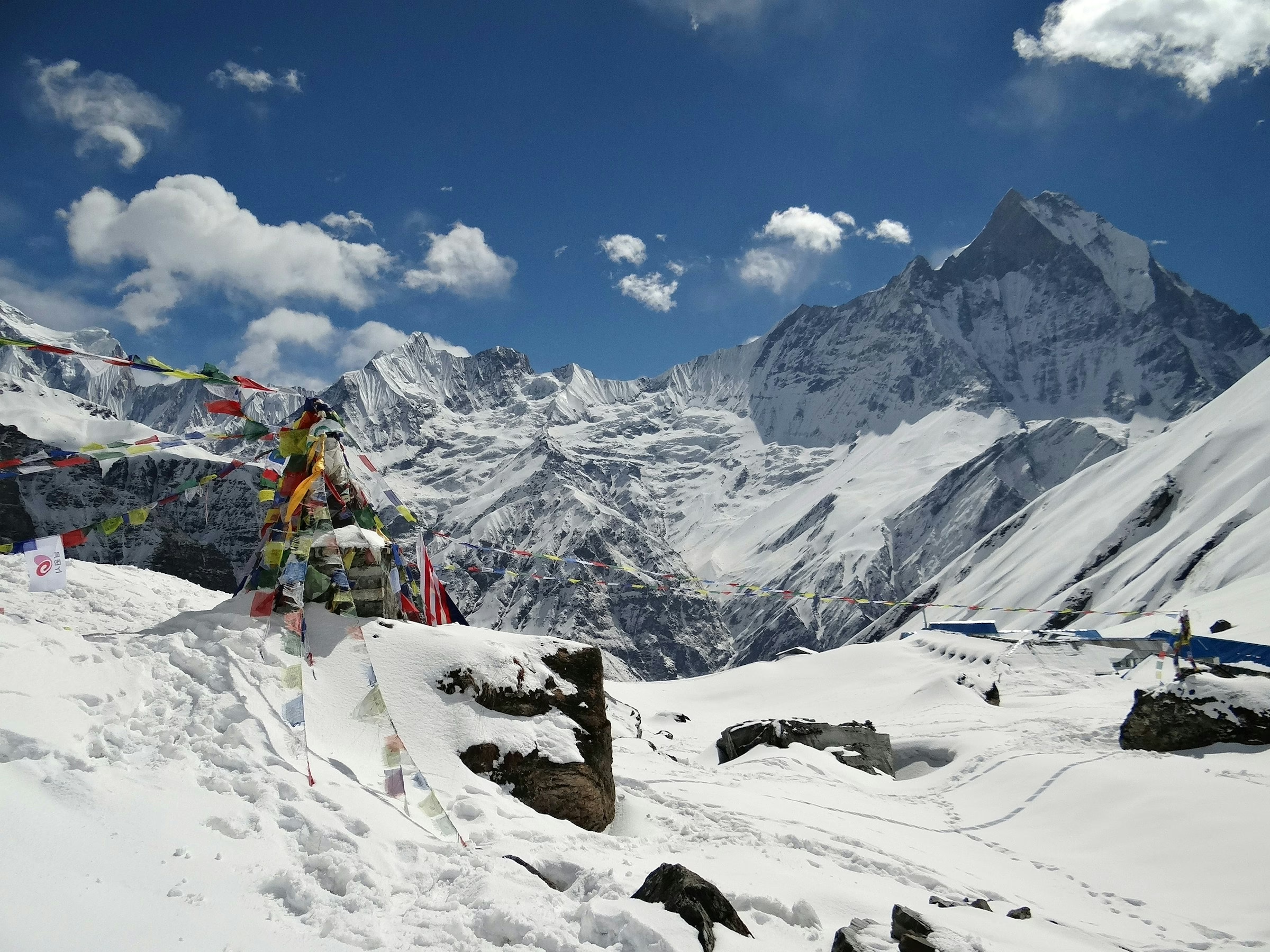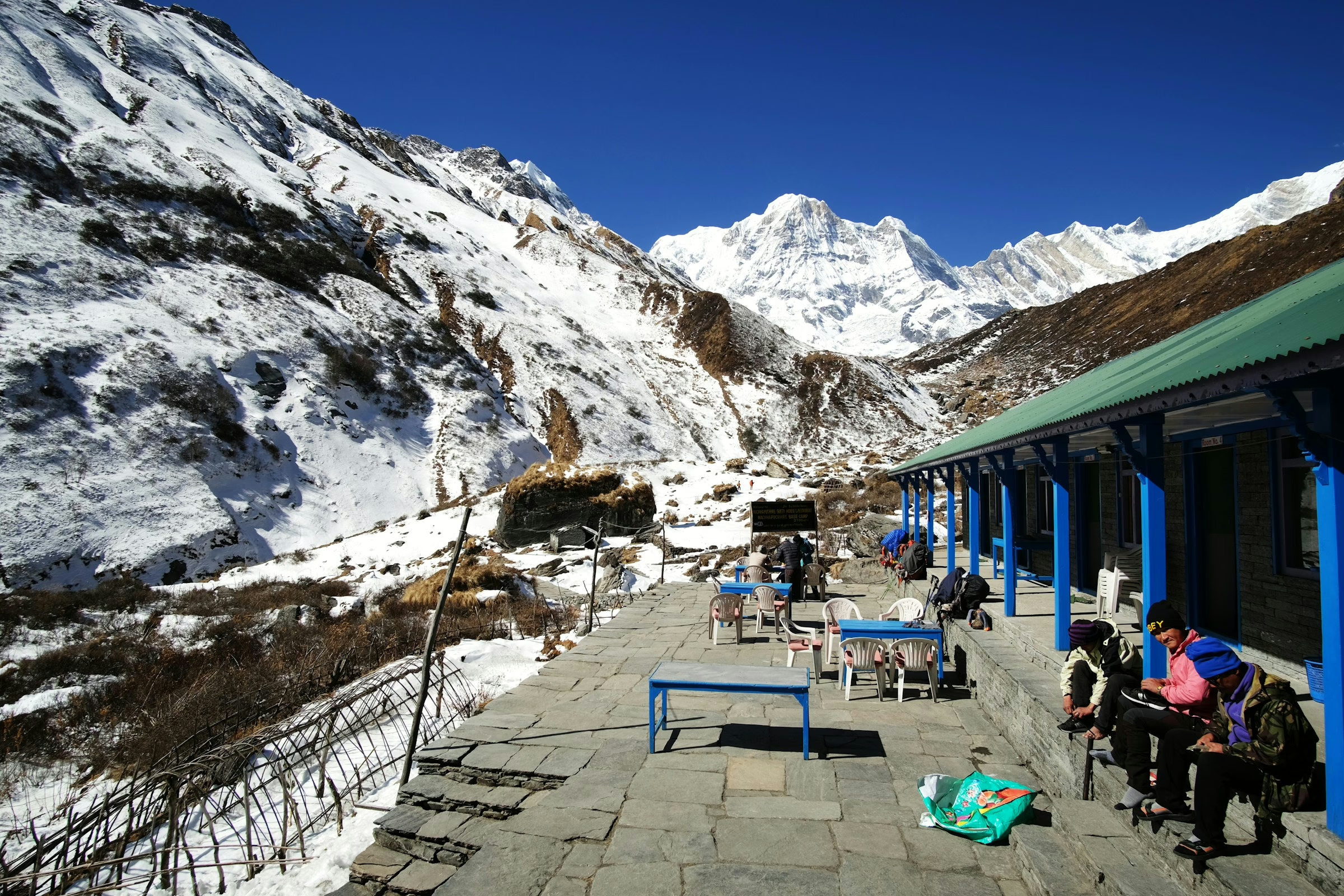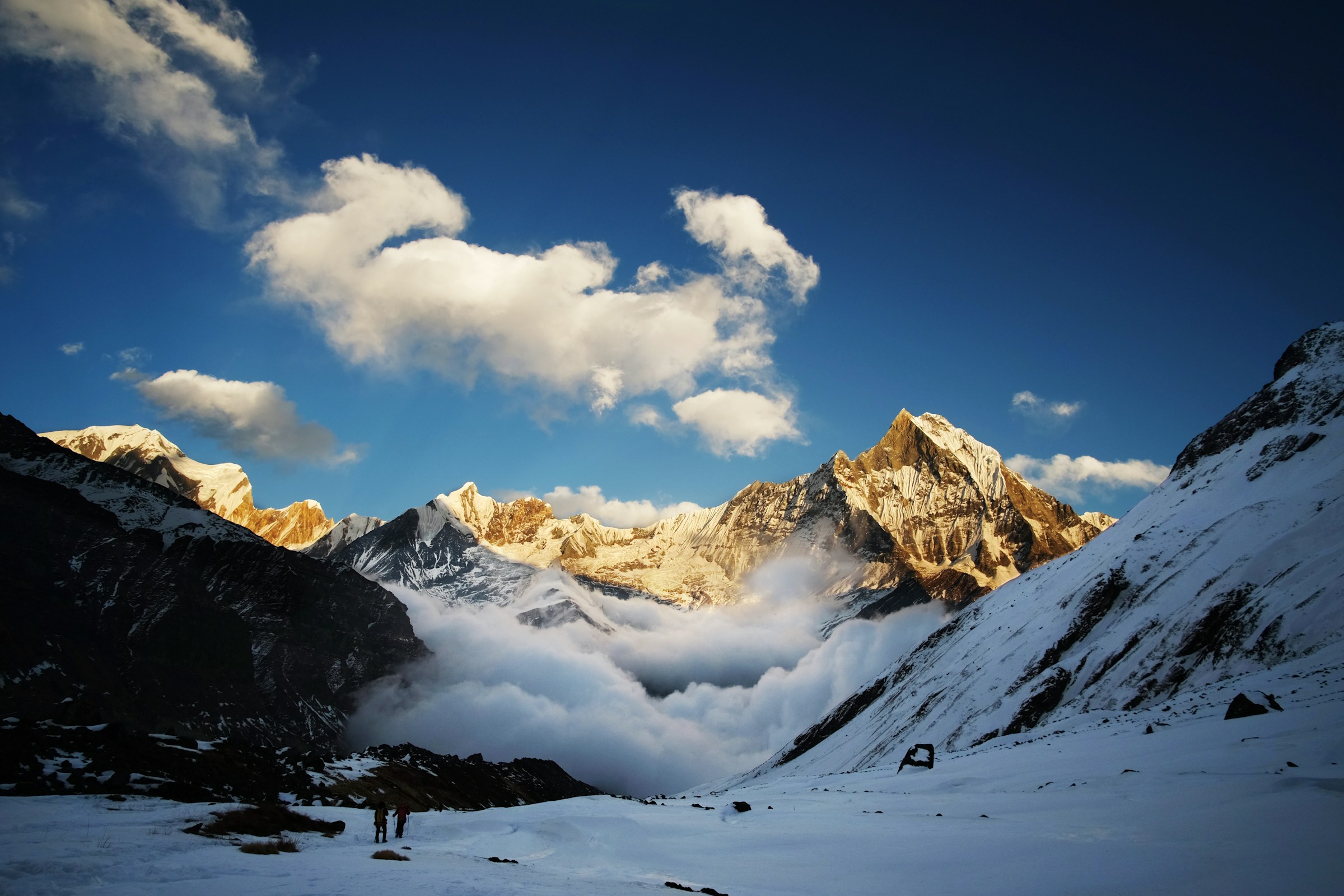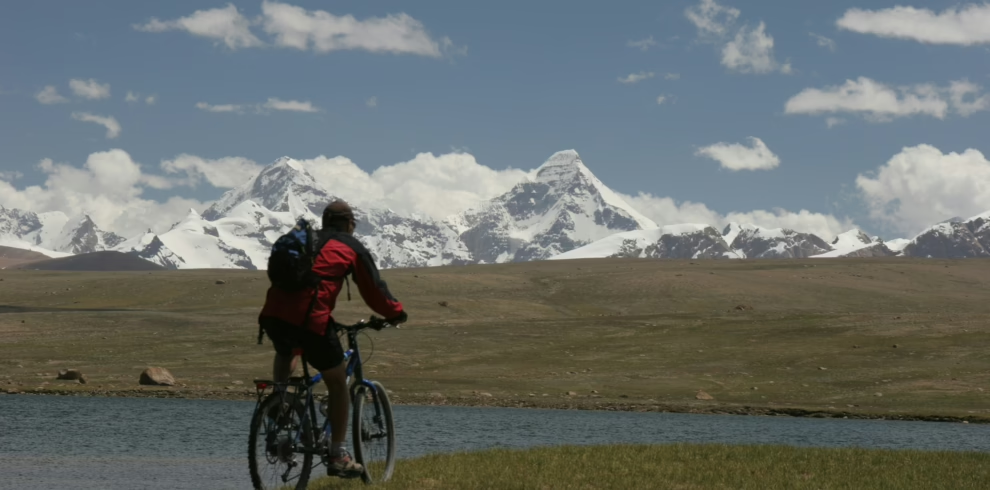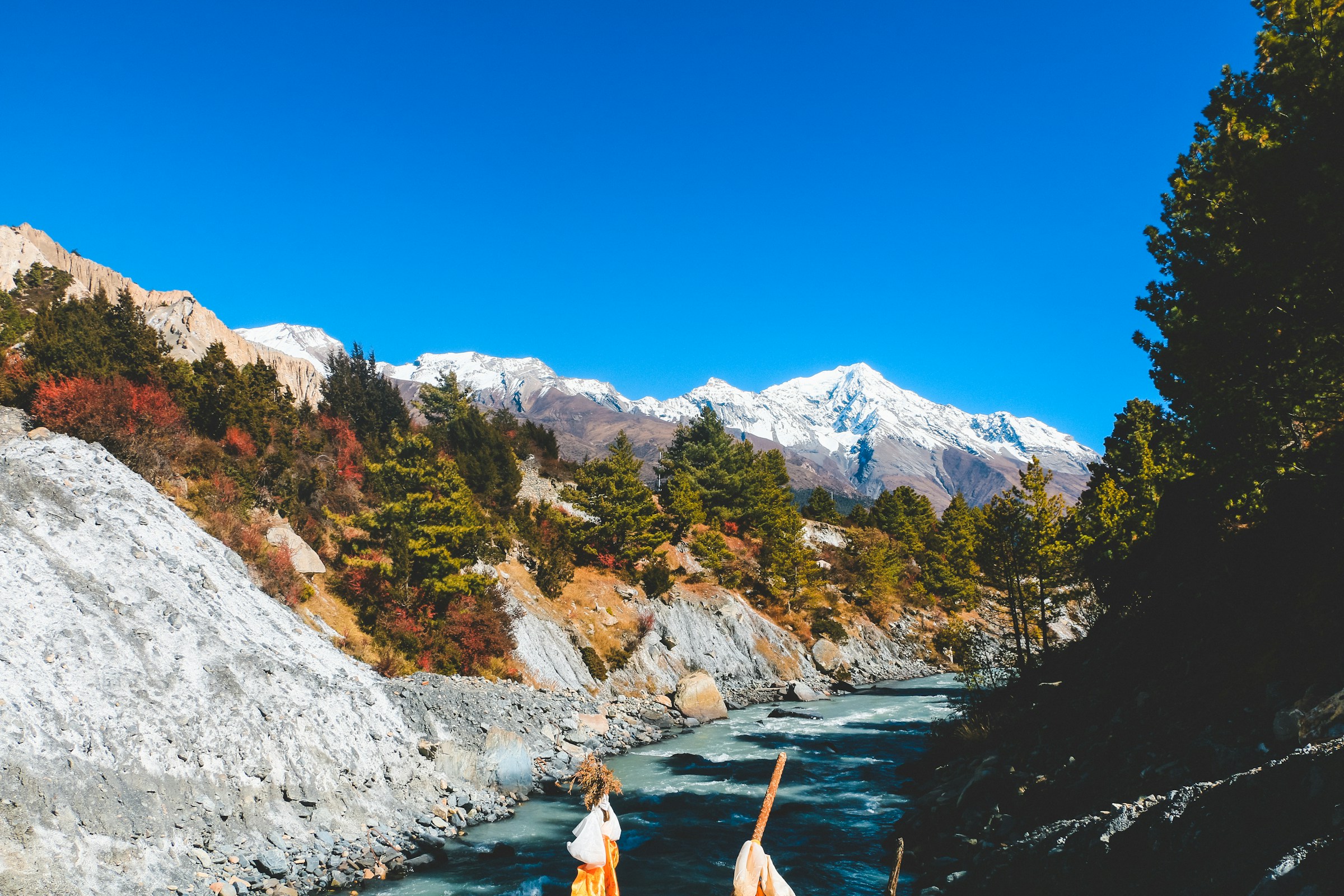Join Green Lotus Trekking for an unforgettable 13-day Annapurna Base Camp Trekking — a professionally designed adventure crafted for those who crave excitement and breathtaking Himalayan scenery.
Within a span of just 60–70 kilometers, you’ll be surrounded by some of the world’s tallest mountains: one soaring above 8,000 meters, thirteen peaks over 7,000 meters, and sixteen more above 6,000 meters. As you trek deeper into the Annapurna region, the panoramic views unfold gradually — each day revealing new layers of snow-capped grandeur and increasing the sense of awe and anticipation.
Reaching Annapurna Base Camp is more than a destination — it’s a crescendo of natural beauty, where the rising sun paints the peaks in gold and ignites a deep sense of wonder. Every morning brings a fresh burst of inspiration as you get closer to the base of towering Himalayan giants.
If you’re looking for a more off-the-beaten-path camping experience, we also offer the Annapurna North Base Camp Trek — ideal for those who want to immerse themselves in the wild, untouched side of the Annapurna region.
Throughout the journey, you’ll walk through a rich tapestry of landscapes — from lush forests and terraced fields to remote villages inhabited by the resilient and proud Gurung community, known for their bravery and deep-rooted traditions.
With stunning views of Annapurna I (8,091 m), Dhaulagiri (8,167 m), Machhapuchhre (6,993 m), Gangapurna, Nilgiri, Lamjung Himal, and more, this trek is a once-in-a-lifetime opportunity to walk in the shadows of giants and experience the cultural heartbeat of the Himalayas.
13 days / 12 nights Annapurna Base Camp trip
Discover the Soul of Nepal in Annapurna Region
Highlights
- Explore Pokhara, the picturesque "Lake City" surrounded by natural beauty.
- Hike through lush rhododendron forests, scenic rivers, terraced fields, and traditional villages of the Magar, Gurung, Tamang, and Thakali communities.
- Immerse yourself in the rich culture, customs, and daily life of local ethnic groups.
- Climb to Poon Hill for a spectacular sunrise view over the Himalayas.
- Discover diverse flora and fauna near the Annapurna Glacier.
- Soak in the soothing natural hot springs at Jhinu Danda.
- Enjoy panoramic views of Annapurna, Dhaulagiri, Nilgiri, Machhapuchhre (Fishtail), and other Himalayan peaks.
- Witness the awe-inspiring snow-covered peaks from Annapurna Base Camp (ABC).
- Visit both Annapurna Base Camp and Machhapuchhre Base Camp on a single trek.
- Stay overnight in Ghorepani, one of the most beautiful villages in the region.
- Spend a memorable night beneath the towering Annapurna peaks at Base Camp.
Annapurna Base Camp Trekking Itinerary
You will be met at Kathmandu's Tribhuwan International Airport by our representative holding a Green Lotus Trekking placard and transfer you to your hotel. Prior to dinner, a trip briefing will be held. You could spend the rest of the day resting or wandering around the city of Kathmandu.
Includes/Excludes
Cost Includes
- All airport to hotel to airport transfers.
- Two nights Kathmandu hotel in 3 star category hotel with daily breakfast.
- One night Pokhara hotel in 3 start category hotel with breakfast.
- Pokhara-Kathmandu airfare ($91 per person).
- Local English speaking guide and porter(s) and their insurance,
- Use of trek pack (i.e. sleeping bag, down jacket, and duffel/kit bag).
- Annapurna Conservation Area and TIMS permit.
- Local land transfers (Kathmadu-Phedi, Nayapul to Pokhara).
Cost Excludes
- International airfare.
- Nepal entry visa fee.
- Travel or trek insurance.
- Kathmandu and Pokhara lunch and dinner expenses.
- On trek meal and accommodations (allow US $20 to $25 per day).
- Gratitude or tips (allow $3 per day per person).
FAQs
You can find good places to trek somewhere in the Himalayas at anytime of the year. However, for most regions, the best time is from October to May, with October to November having the best weather for trekking. During the autumn, nights are cold in the high Himalaya, but the bright sun makes for a pleasant daytime temperature (20 degrees centigrade to 5 degrees centigrade in the night). Above 3500m, the temperature range goes down to -10 degrees centigrade, and in winter (Dec-Jan), it is about 10 degrees colder.
While you do not need to be super-fit, you need to be fit enough to comfortably walk for 5–6 hours per day in the mountains on reasonable trails. Most of our customers have an interest in walking in the hills or countryside of their homeland and are used to similar daily trips.
We pride ourselves on our small group approach to adventure travel. Small groups allow you to share great company without crowding your experience. Our typical groups range in size from 2 up to 8. One of the attractions of such a trip is the chance to meet people with different backgrounds and personalities.
If this is the case, we can organize a personalized trek for you. Additionally, if you want to spend more time in Kathmandu before or after a trek, we can organize the hotels and quote you a price.
If you are a group of two or more, the trip is guaranteed to run.
Usually, our clients simply bring their existing clothing and equipment and, if necessary, supplement this with some extra items purchased cheaply in Kathmandu.
What gear to bring?
- Passport (with photocopies)
- Photos for Nepal visa on arrival:
- Travel insurance (with photocopies)
- flight tickets (photocopies)
- Daypack for daily personal items
- For Trekking:
- Walking boots
- Light sandals or plimsolls to wear in the lodges
- 2 pairs of underwear.
- 2 pairs of walking socks.
- 2 thick fleece or warm shirts
- 1 pair thin thermal underwear
- Long trousers for walking (or a long skirt for women)
- T-shirt
- Shorts
- Gloves (it’s cold on the Thorung La, Laurebina Pass and Cho La)
- Warm hat which covers your ears (for the Kali Gandaki and Thorung La – it’s windy)
- Base ball caps or broad brim hats to keep the sun off (Australian Barmah recommended)
- Sunglasses (vital)
- Sun cream
- Soap dish and soap
- Small Towel
- Toothbrush and toothpaste.
- Wet wipes / Moist towelettes
- Hand sanitizing lotion
- Head torch
- Moisturizer, Lip balm
- Tampons are hard to buy in rural areas.
- Ear plugs for light sleepers
- Toiletries
- Sheet of plastic (use as a poncho if it rains)
- 1 toilet paper roll. (You can buy more on the way.)
- 2 large plastic bags. One for smelly clothes, one for things that must be kept dry.
- A small, good quality padlock
- Water bottle
- Iodine tablets for water purification
- Protein bars, chocolate, dried fruits, candies, and snack foods.
Notes: All of the trekking items are available in Kathmandu at nominal prices. However, we suggest you bring hiking boots from your home country if you decide to purchase these items in Kathmandu .
Yes, all hotels provide storage facilities for free.
Personal travel insurance is not included in the tour price. It is a condition of booking a tour with Green Lotus Trekking, and your responsibility to ensure the type of tour you are undertaking; the policy must include satisfactory cover for repatriation, high altitudes, trekking and climbing, and helicopter rescue. Please forward your insurance details (e.g. policy number, 24-hour emergency telephone number, and name of insurance company) to Green Lotus Trekking when available.
Yes. You can apply in your home country through the Nepalese Embassy or Consulate or obtain it at the airport on arrival by paying a fee as below:
- Multiple entries for 15 days: $25 USD
- Multiple entries for 30 days: $40 USD
- Multiple entries within 90 days: US $100
- Notes: We suggest you bring the exact change. You also need to bring two passport-size photos.
Tourist Visa Extension
The visa extension fee for 15 days or less is US $ 30 or equivalent convertible currency, and the visa extension fee for more than 15 days is US$ 2 per day.
A tourist visa can be extended for a maximum period of 150 days in a single visa year (January–December).
Gratis (Free) Visa
A gratis visa for 30 days is available only for tourists from SAARC countries.
Indian nationals do not require a visa to enter Nepal.
Normally single trekkers have no problems fitting in with a group. Normally single trekkers share rooms or lodges with other trekkers of the same sex, but if we have an odd-number we ensure that a room or lodge is organised accordingly.
To confirm your booking, we will require a deposit of $250 for treks and $300 for peak climbing, which can be made by bank transfer or online through paypal.com (the leading transaction site). The balance is payable on arrival in Kathmandu with cash or traveler cheque. Alternatively, the balance can be paid by bank transfer or PayPal shortly before arriving in Kathmandu.
The following details are needed to process your trekking permit, national park permit, flight booking etc.
- Gender:
- First Name:
- Last Name:
- Passport number:
- Expiry date:
- Issue location:
- Nationality:
- Year of birth:
- Occupation:
- Your arrival details (time, date, flight number, airline):
All the above info can be sent electronically via email.
You will typically walk 4–9 miles (5-8 hours) each day. Some days may be rest days for impromptu exploration. In high and steep areas, you may move more slowly. Most people begin to feel the effects of high altitude over about 2000 meters, and your trekking pace is always adjusted to permit safe acclimatization. Our treks follow established trails used by local people. You will probably carry only a light daypack.
You can hike at your own pace, stopping when you wish. There is ample time to cover the necessary hiking distance each day with lots of stops. If you are on a private trek, you may wish to take more or fewer days to cover a given distance, or add in rest days. If you like to hike fast, your guide will be concerned that you acclimatize to high altitude effectively. You may wish to reach camp at a measured pace, but take a side hike after arriving at camp. Your guide is always interested in learning about your personal interests and accommodating those interests as the trip permits.
Altitude sickness, often known as acute mountain sickness (AMS), is a particularly important medical consideration while trekking in Nepal. Altitude sickness means the effect of altitude on those who ascend too rapidly to elevations above 3000 meters. The initial symptoms of AMS are as follows:
- nausea, vomiting
- Loss of appetite
- Insomnia or sleeplessness
- Persistent headaches
- Dizziness, light headaches, confusion,
- Disorientation, drunken gait
- Weakness, fatigue, lassitude, heavy legs, slight swelling of hands and face.
- Breathlessness and breathing irregularly
- Reduced urine output
These symptoms are to be taken very seriously. In the event of the appearance of any of the above symptoms, any further ascent should be reconsidered; otherwise more serious problems can occur, which can cause death, sometimes within a few hours. The only cure for altitude sickness is to descend to lower elevations immediately. Acclimatization by ascending to no more than 300 to 500 meters per day above 3000 meters and the proper amount of rest are the best methods for prevention of AMS.
Our itineraries are designed so that our clients ascend at a sensible and safe rate. The effects of altitude are felt by everyone, even the Sherpas, but most people find that gentle acclimatization allows them to reach their high point without any problems.
Accommodation: There are a number of lodges along the popular trekking routes in the Annapurna, Everest, and Langtang regions. These lodges are called “Tea House Lodges” and are managed by local people. Private rooms, dormitories, toilets, shower rooms with hot and cold water, and one attached restaurant are among the basic requirements for overnight accommodation at these lodges.The quality of food offered might vary from lodge to lodge, but most serve simple and hygienic meals. The teahouse trek provides you an opportunity to feel the warm hospitality of friendly Nepali hosts. The money you spend goes to the local community.
Camping Trekking
In a typical camping trip, each pair of trekkers will sleep in a spacious mountain tent with a durable rain fly and full insect netting. The tent is fitted with foam mattresses. When your campsite is near villages or lodges, you may be invited to sleep in the lodges or homes of local people.
Breakfast options include oatmeal,French toast,Chapatti, Tibetan bread, eggs, pancakes, muesli, and for lunch or dinner you can have sandwiches, soups, momo (dumplings), macaroni dishes, pizzas, noodles, steak, dal bhat (rice, lenthal, veg platter), pasta, etc.
Our trekking guides are carefully selected for their ability and are generally from Sherpa, Tamang, Gurung, Magar, and other communities from remote mountain villages. Each guide is trained in eco-friendly trekking methods and safety measures. They help to maintain your health and your happiness as well as the crew members. Our guides are committed to making sure that all our trekkers have an enjoyable trek, come back safe and are overwhelmed by their experience. Your guide will be a friend and companion, who takes pleasure in showing you his country’s specialties and, perhaps, meeting his home and family too.
The majority of the fees our clients pay go directly into the community where you trek.
Tipping is at your discretion and always appreciated. A good rule of thumb is anywhere from $2–5 dollars per day for the guide and $1.5–3 dollars per day per porter. The total amount can then be divided among the group.
Please have them contact us at any of the following numbers:
Cells: +977-9841250258, +977-9841269376
We check email frequently throughout the day, so you could also write to our email: info@green-lotus-trekking.com if it’s not urgent.
Map

The Annapurna Base Camp (ABC) 13-Day Trek offers stunning views of the majestic Annapurna Himalayan Range and the diverse natural beauty of Nepal. This once-in-a-lifetime journey takes you through terraced farmlands, colorful rhododendron forests, traditional villages, and towering snow-capped peaks—all set within the breathtaking Annapurna region of Gandaki Province.
The trail features a mix of steep ascents and descents along rocky paths, passing through culturally rich villages where you can experience the customs, lifestyles, and warm hospitality of various ethnic communities. Staying in these villages offers a unique opportunity to appreciate the simplicity and charm of rural Himalayan life.
Your adventure begins with a scenic drive from Kathmandu to Pokhara, followed by a short ride to Nayapul—the trek’s starting point. From there, the route leads through the villages of Tikhedhunga, Ghorepani, Poon Hill, Tadapani, Chhomrong, and Deurali before reaching Annapurna Base Camp.
After exploring the base camp and soaking in the panoramic views, the descent takes you through the Modi River Valley to Sinuwa for an overnight stay. The next day, you’ll trek to Jhinu Danda, where you can relax in natural hot springs. From Jhinu Danda, continue to Siwai and then drive back to Pokhara. The trek concludes with a comfortable tourist bus journey back to Kathmandu.
At Green Lotus Trekking Pvt. Ltd, we’re proud to offer this well-organized 13-day Annapurna Base Camp Trek itinerary—designed to provide a memorable and rewarding experience. Bookings are now open for 2025 and 2026, and we’re happy to customize the itinerary based on your schedule, budget, and fitness level.
For pricing or further inquiries, feel free to contact us.
Benefits of Booking the Annapurna Base Camp Trek with Us
- Complimentary international airport pick-up and drop-off
- Annapurna Base Camp Trek map
- First-aid medical kit provided when necessary
- Free luggage storage at our office during the trek
What to Expect on the 13-Day Annapurna Base Camp Trek?
- Hike through remote villages, enchanted forests, and open moorlands with glacial rivers and starry Himalayan nights.
- Enjoy a magical sunrise over the Annapurna Range from Poon Hill—a rewarding early-morning climb.
- Relax post-trek in Pokhara, where you can take a peaceful boat ride on Phewa Lake or unwind with a rejuvenating massage.
- Be guided by experienced trek leaders, assistant guides, and porters who not only assist you but also share insights into the local Sherpa culture.
- Trek with a company committed to responsible tourism, ensuring fair, safe, and ethical working conditions both in Nepal and worldwide.
Is the Annapurna Base Camp Trek Right for You?
- This 13-day trek involves daily hikes of up to 8 hours, sometimes at altitudes above 4,000 meters. Be mindful of altitude sickness risks.
- Prepare physically and mentally by training several weeks in advance. Cardiovascular fitness is key.
- Accommodation is in basic teahouses, offering essential amenities only. Charging electronic devices may come at an extra cost. Hot showers and Wi-Fi may not always be available.
- The trek is popular, so expect to encounter many fellow trekkers along the trail and at overnight stops.
- Be aware: itinerary changes may occur due to extreme weather or trail conditions.
Preparation Tips for the ABC Trek
- Rated moderate to challenging, the trek includes long ascents, steep descents, and mixed terrain.
- Daily hikes range from 6 to 7 hours. No technical skills are required, but prior trekking experience is helpful.
- Practice by doing local hikes or day-long walks that include uphill and downhill trails.
- Improve stamina through cardio exercises such as running, swimming, or cycling. Yoga and breathing exercises are also beneficial.
- Stay hydrated and maintain a positive, determined mindset for a more enjoyable experience.
- If you have pre-existing health conditions (heart, lung, or chronic issues), consult a doctor and inform us before booking.
Useful Information for Annapurna Base Camp Trekking
Best Time to Visit Annapurna Base Camp Trek
- Spring (March–May): Spring offers sunny days, clear skies, and vibrant greenery, making it the busiest trekking season. Rhododendrons bloom beautifully at lower altitudes, and pine forests are fresh and fragrant. Though warm during the day, mornings and evenings at higher elevations can be cool.
- Autumn (September–November): Another popular season with stable weather and stunning mountain views. The trails are busier, and teahouses fill up quickly due to the overlap with Nepal’s festive season. While staff may be stretched thin, the festive atmosphere adds cultural charm to your journey.
Food on the Annapurna Base Camp Trek
You’ll enjoy a variety of meals, from traditional Nepali dishes to international cuisines like Tibetan, Continental, Italian, and Indian.
- Breakfast: Tibetan bread, chapati, porridge, pancakes, cornflakes, muesli, eggs (various styles), hash browns, French toast, vegetables, and hot drinks.
- Lunch & Dinner: Dal bhat, thukpa, momos, chapati, macaroni, spaghetti, sherpa stew, sandwiches, curry with rice, burgers, pizza, steaks (including yak), spring rolls, and various soups and desserts.
Meals are provided during the trek. In Kathmandu and Pokhara, only breakfast is included.
Accommodation on the Trek
Teahouses and trekking lodges are available along the route—no need to bring tents. Lodging is basic but comfortable, with twin-sharing rooms featuring wooden beds, mattresses, blankets, and pillows. Some offer attached bathrooms. Private rooms are available at lower elevations and in cities but are limited at Deurali and Annapurna Base Camp.
Trek Difficulty
The Annapurna Base Camp Trek is considered moderate. Most days involve 5–6 hours of walking over steep and rocky terrain, including stone steps. No technical skills are needed, but good fitness, patience, and confidence are essential. The trek gradually ascends, helping your body acclimate. Prior hiking experience is helpful but not required. The maximum altitude is 4,130 meters.
Travel Insurance
Due to the high altitude and potential risks (e.g., altitude sickness, landslides), travel insurance is mandatory. Your policy must cover medical treatment, emergency evacuation, and helicopter rescue at high altitudes. Green Lotus Trekking requires a copy of your insurance certificate before the trek begins.
Altitude Sickness & Prevention
Altitude sickness (Acute Mountain Sickness) can occur above 3,000 meters due to reduced oxygen levels. Symptoms include headache, nausea, fatigue, dizziness, insomnia, and loss of appetite.
Prevention Tips:
- Stay hydrated and avoid alcohol.
- Maintain a balanced diet.
- Ascend slowly and acclimatize properly.
- Carry and use Diamox if needed.
- Monitor your body and descend if symptoms worsen.
- Maintain hygiene to avoid illness.
Packing List
Essential items include a sleeping bag, warm clothing, trekking boots, poles, gloves, socks, sunglasses, sunscreen, and a duffel bag. Choose lightweight and comfortable clothing suitable for high-altitude trekking. Don’t forget important documents and follow guidelines for restricted and permitted items.
Trekking Guide & Safety
Green Lotus Trekking prioritizes client safety through the following measures:
- Experienced guides trained in wilderness first aid.
- Continuous support and motivation from trek leaders.
- Careful evaluation of food and accommodation hygiene.
- Provision of necessary gear and first aid kits.
- Authority to adjust or end the trek if health concerns arise.
Booking Procedure
Green Lotus Trekking is a registered, government-approved trekking company with over years of experience. We are members of NMA and TAAN.
To confirm your booking:
- Pay a 10% deposit.
- Submit the following within one week: passport copy, two passport-sized photos, travel insurance, and flight details.
We accept payments via Western Union, bank transfer, and online (through our website). The remaining balance can be paid in Kathmandu via cash, transfer, or credit card. Payment instructions will be shared upon booking.

